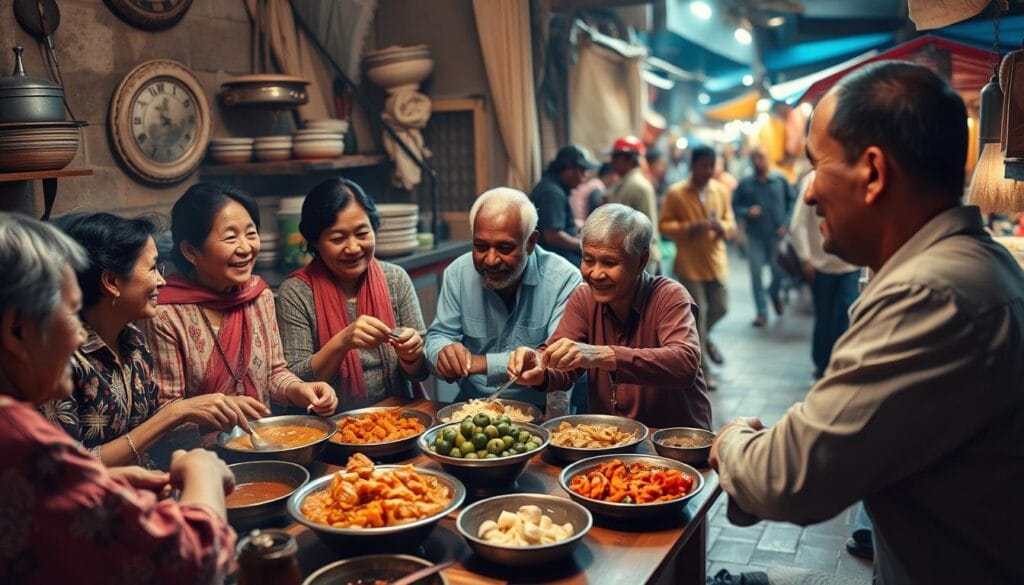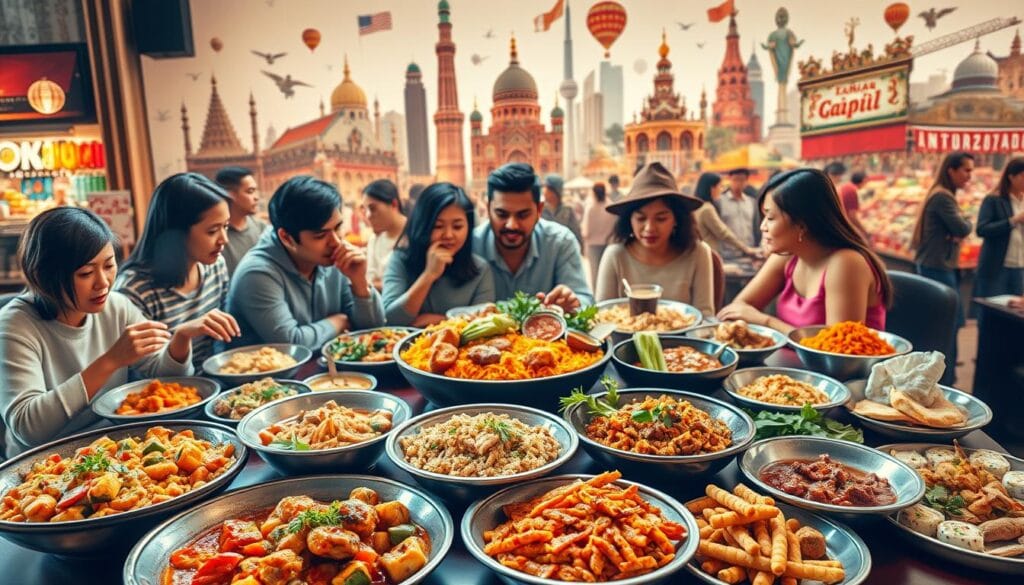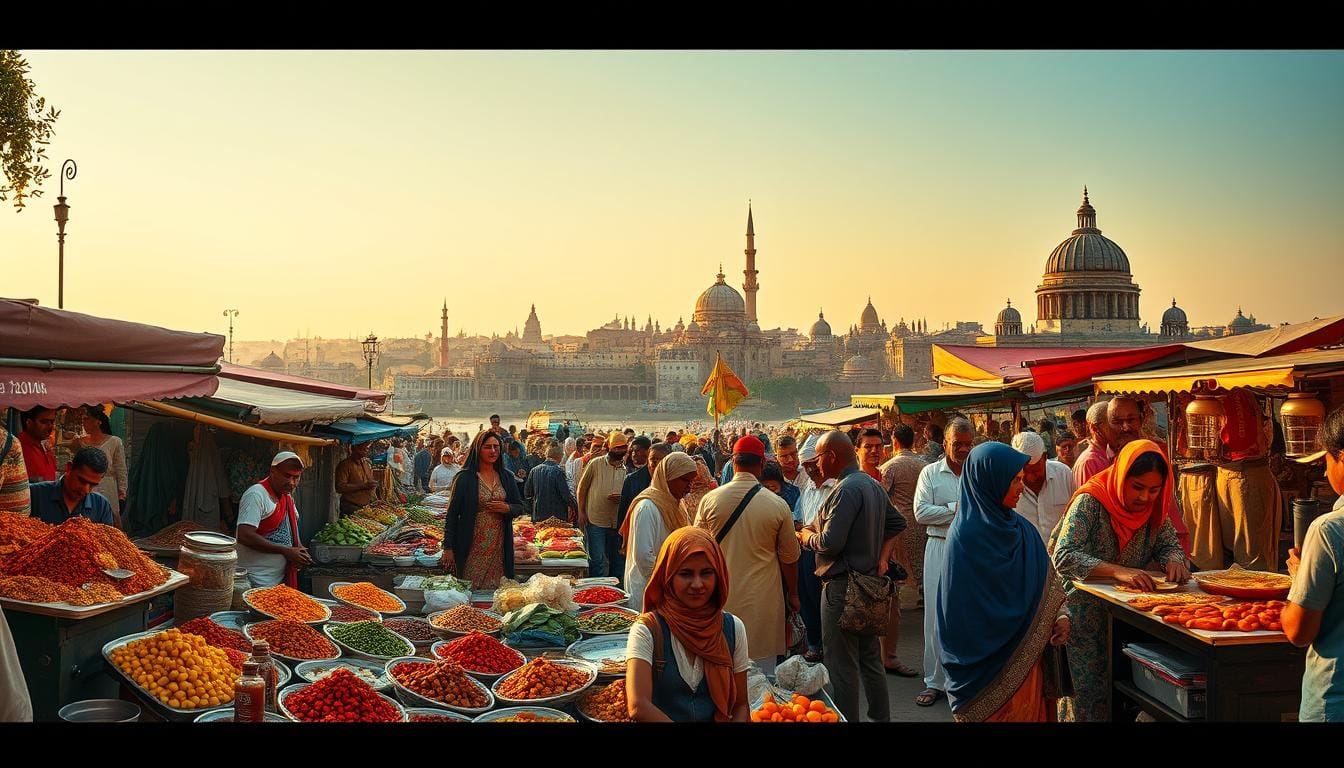10 Ways Food and Culture Shape Traditions Worldwide
Food and Culture
Food is more than just something we eat. It tells our story and shows who we are. UNESCO has recognized 30 food and drink traditions as part of our cultural heritage. These include South Korean kimchi and French baguettes.
These traditions connect us to our past and to each other. When Ukrainian borscht was added to UNESCO’s list in 2022, it was more than just a soup. It was about keeping our cultural roots alive. China’s tea culture, with its 2,000 varieties, also got recognition that year, showing centuries of tradition.
Studies from the University of Oxford found that sharing meals makes us feel happier. This is why food is so important during religious celebrations. In fact, 75% of people say food is key to their religious practices.
For immigrant communities, traditional foods are a strong connection to their heritage. The flavors of home dishes help keep their identity alive, even in new places. This global food culture is a beautiful mix of customs that both unite and divide us.
Key Takeaways
- UNESCO recognizes 30 food traditions as part of humanity’s cultural heritage
- Traditional foods like kimchi, borscht, and baguettes preserve cultural identity
- Sharing meals increases feelings of happiness and connection
- Religious celebrations worldwide center around specific food customs
- Immigrant communities maintain heritage through traditional cooking
- Food traditions serve as living history that connects generations
The Connection Between Culinary Practices and Identity
The foods we make and eat connect us deeply to our culture. Research finds that 70% of people see food as key to their cultural identity. This shows a strong bond between taste and personal history.
Exploring Personal Heritage
Family recipes are like windows into our past. Making traditional dishes brings families together, like Mexican tamales during holidays. They carry memories and a sense of belonging.
Impact of Immigration on Cuisine
Immigrants change local food scenes while keeping their cooking traditions alive. Chinese and Italian immigrants faced early criticism of their food. But now, these dishes are beloved in America.
Louisiana’s Creole cuisine is a great example of cultural blending. It mixes French, Spanish, African, and Caribbean flavors into something unique.
Food as a Symbol of Belonging
Sharing meals brings people together and shows who belongs. Ethiopian meals on shared platters with injera bread highlight unity. Cooking together, like at potlucks, celebrates and keeps cultural traditions alive.
For immigrants, traditional foods are a comfort in new places. They offer a taste of home in unfamiliar surroundings.
Festivals Celebrating Culinary Diversity
Food festivals are lively displays of culinary diversity. They bring people together by sharing flavors and traditions. These events turn public areas into places filled with smells, tastes, and cultural exchanges.
Iconic Food Festivals Around the World
Oktoberfest in Germany welcomes six million visitors each year. The Taste of Chicago features over 80 local restaurants. The Melbourne Food and Wine Festival highlights Australia’s diverse ethnic cuisine with more than 100 events.
In Europe, Naples’ Pizzafest celebrates pizza-making with competitions. The Galway International Oyster Festival draws 20,000 seafood fans. Bangkok’s Vegetarian Festival is a big event for plant-based dishes in Thai tradition.
The Maine Lobster Festival attracts nearly 100,000 visitors. They come for fresh seafood and to celebrate coastal heritage. These festivals strengthen cultural ties and help local economies.
Unique Dishes at Local Celebrations
Smaller local events offer dishes you can’t find elsewhere. The Dragon Fest highlights East Asian dumplings and stir-fries. Puck Fair in Ireland combines 400-year-old food traditions with live music.
Brooklyn’s Vegan Night Market shows off new plant-based versions of classic ethnic cuisine. The Creole Food Festival in New York City offers a mix of African, French, Spanish, and Native American dishes.
These events keep culinary traditions alive while encouraging cultural exchange. Whether trying Thailand’s southern curries or Texas brisket at Taste of Dallas, people dive into culinary diversity. They join in on traditions that grow and change with each new generation.
Traditional Cooking Methods Across Cultures
The kitchen is like a living museum, where ancient knowledge meets fire, water, and skilled hands. Studies reveal that over 70% of people see food as a key link to their heritage. These cooking methods not only feed our bodies but also keep cultural identities alive through generations.
Techniques Passed Down Generationally
In Chinese families, making dumplings brings people together. Grandparents teach younger ones the art of folding. This teaches patience and improves cooking skills by up to 50% for regulars.
In the Southern United States, barbecue is a family tradition. It involves secret spice blends and smoking techniques passed down for over 100 years. These recipes are family treasures.
Traditional foods often show deep cultural adaptations. Our ancestors’ cooking innovations led to our bodies being smaller and having shorter digestive tracts. These traditions also support local economies, with about 80% of local farmers benefiting.
The Role of Cooking Utensils in Tradition
Special tools shape both dishes and cultural practices. In Morocco, clay tagines keep moisture in during slow cooking, showing desert conservation. Cast iron pots in West Africa build flavor over generations, carrying taste memories.
In Japan, the donabe earthenware pot creates unique textures not found in modern cookware. Many traditional cooking tools reduce environmental impact by up to 40% compared to modern methods. Tools like the mortar and pestle in Thai kitchens release flavors that electric processors can’t match.
These tools are more than kitchen equipment. They represent culinary traditions and preserve cooking wisdom that might be lost in our fast-paced world.
Food as a Catalyst for Community Bonds
Sharing meals has long been a way to connect people from different backgrounds. It’s more than just eating together; it’s about building relationships. Studies show that people who share meals often feel happier and more fulfilled.
Even simple dishes become special when shared with others. This makes food a powerful tool for creating bonds.

Potluck Traditions in Different Cultures
Potluck gatherings are a universal tradition that brings people together. In Scandinavian smörgåsbord, everyone brings a dish to share. In North America, neighborhood potlucks help build community through food.
These meals are common in Western communities, fostering social bonds. In Korea, Chuseok celebrations involve making rice cakes together, strengthening family bonds. The Big Lunch in the UK shows the power of food in reconnecting people, with 7.3 million participants last year.
Shared Meals and Their Social Importance
Yet, modern life often leads to eating alone. Adults eat 10 meals a week by themselves, with many dinners eaten in solitude. Sadly, 69% of people have never shared a meal with their neighbors.
Food brings people together, as seen in Spanish tapas and Ethiopian meals. These traditions go beyond food, creating a sense of belonging.
Sharing meals is seen as a key to stronger relationships. This wisdom is shared across cultures, from Jewish weddings to community meals in crises. Food is not just for our bodies but also for our need for connection.
Rituals and Food: From Birth to Death
Food is key in our life’s big moments, linking us to our past through cultural gastronomy. It welcomes us into the world and says goodbye to those we love. These traditions bring comfort and keep our cultures alive.
Culinary Customs in Birth Celebrations
Births bring special food traditions that introduce babies to their heritage. In China, “red egg and ginger” parties celebrate with eggs dyed red for good luck. In India, new moms get dishes like panjiri to help them heal and nurse.
Mexican families celebrate baptisms with big feasts and mole, a sauce that mixes old and new traditions.
Food and Mourning Traditions
When we lose someone, food customs offer comfort. Jewish shiva meals use round foods like eggs to symbolize life’s cycle. In Mexico, families make their loved ones’ favorite dishes for Day of the Dead.
In Africa, funeral feasts feed mourners and strengthen community ties. These traditions change but keep their core meaning. They show how cultural gastronomy stays true to its purpose, even as it evolves.
Influence of Globalization on Local Cuisines
Food traditions now travel fast across borders in our connected world. Globalization has made seasonal and non-native foods 30% more available all year. This change is reshaping local markets and kitchens everywhere. It brings both benefits and challenges to keeping ethnic cuisine alive.

Fusion cuisine is where different cooking traditions meet in new ways. Think Korean-Mexican tacos, Japanese-Peruvian Nikkei dishes, and Indo-Chinese creations. These dishes show how food culture grows through mixing cultures.
Numbers show the impact is mixed. Small farmers see a 40% income boost from global markets. Yet, Western diets have cut traditional eating by 15%. Food transport is also a big source of greenhouse gas emissions, adding 14% to global emissions.
People around the world are working to save their food traditions. The Slow Food movement supports local foods and old cooking ways. Laws protect special foods like Champagne and Parmigiano-Reggiano. Digital archives are saving recipes that might be lost.
Finding the right balance is key. Many places mix in new ideas while keeping their food heritage. In the U.S., farm-to-school programs grew 50% from 2006 to 2009. This helps kids connect with local foods. It lets ethnic cuisine grow and stay meaningful in our global food scene.
The Role of Food in Religious Practices
Food is a sacred language in many faiths, showing deep beliefs and values. It creates unique identities and brings people together. Religious food rules are some of the oldest and most lasting in human history.
Dietary Restrictions and Their Cultural Significance
Religious food laws are more than just rules. They carry deep spiritual meanings. For example, about 65% of Muslims follow halal rules, avoiding pork and specific slaughtering methods.
20% of Jews keep kosher, separating dairy and meat. These rules are not just about food. They show faith and cultural identity. For Hindus, not eating beef honors cows. Many Buddhists choose vegetarianism to show non-violence.
Traditional Dishes for Religious Celebrations
Special foods mark important religious times in many cultures. During Ramadan, 90% of Muslims gather for iftar meals after fasting. This strengthens family bonds.
At Diwali, 70% of Hindu families make special sweets and dishes. These foods symbolize joy and good fortune. In Jewish homes, Passover seder plates have foods like matzah, linking today to yesterday.
Christians often eat lamb at Easter, seeing it as the “Lamb of God.” These foods turn simple meals into spiritual experiences. They keep cultural heritage alive through taste and smell, connecting families across time.
Future Trends: Where Food and Culture Are Heading
The mix of culinary diversity and global food and culture trends is set to evolve further. Sustainable cooking methods are getting more love, with old techniques like fermentation and low-waste cooking coming back. At the same time, new plant-based versions of classic dishes are changing how we see food.
Now, you can find vegan Mexican spots and plant-based Chinese dishes everywhere. Chefs and home cooks are mixing old traditions with new, sustainable ideas. This shift shows how people are moving towards healthier, more eco-friendly food choices.
The future of food and culture is bright and full of change. We’ll see more tech in kitchens, a focus on healthy foods, and a love for traditional cooking. Food will keep being a key way to share and celebrate cultures in our complex world.

